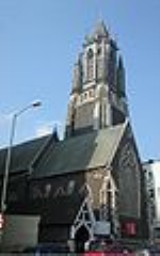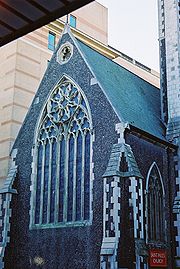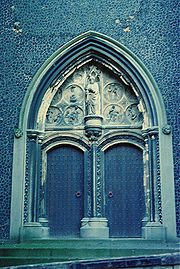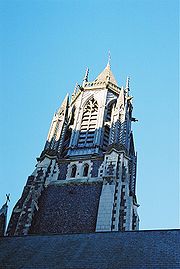
St Paul's Church, Brighton
Encyclopedia

Church of England parish church
A parish church in the Church of England is the church which acts as the religious centre for the people within the smallest and most basic Church of England administrative region, known as a parish.-Parishes in England:...
in Brighton
Brighton
Brighton is the major part of the city of Brighton and Hove in East Sussex, England on the south coast of Great Britain...
in the English
England
England is a country that is part of the United Kingdom. It shares land borders with Scotland to the north and Wales to the west; the Irish Sea is to the north west, the Celtic Sea to the south west, with the North Sea to the east and the English Channel to the south separating it from continental...
county of Sussex. It is located on West Street in the city centre, close to the seafront and the main shopping areas.
History and construction
The church was the fourth to have been built on the instruction of Rev. Henry Michell Wagner, Vicar of Brighton since 1824. His first was All Souls on Eastern Road, built between 1833 and 1834 but demolished in 1968. This was followed by Christ Church on Montpelier Road in MontpelierMontpelier, Brighton
Montpelier is an inner suburban area of Brighton, part of the English city and seaside resort of Brighton and Hove. Developed together with the adjacent Clifton Hill area in the mid-19th century, it forms a high-class, architecturally cohesive residential district with "an exceptionally complete...
, near the boundary with Hove
Hove
Hove is a town on the south coast of England, immediately to the west of its larger neighbour Brighton, with which it forms the unitary authority Brighton and Hove. It forms a single conurbation together with Brighton and some smaller towns and villages running along the coast...
, to which King William IV
William IV of the United Kingdom
William IV was King of the United Kingdom of Great Britain and Ireland and of Hanover from 26 June 1830 until his death...
, his Queen Consort
Queen consort
A queen consort is the wife of a reigning king. A queen consort usually shares her husband's rank and holds the feminine equivalent of the king's monarchical titles. Historically, queens consort do not share the king regnant's political and military powers. Most queens in history were queens consort...
Adelaide
Adelaide of Saxe-Meiningen
Princess Adelaide of Saxe-Meiningen was the queen consort of the United Kingdom and of Hanover as spouse of William IV of the United Kingdom. Adelaide, the capital city of South Australia, is named after her.-Early life:Adelaide was born on 13 August 1792 at Meiningen, Thuringia, Germany...
and his successor Queen Victoria had each contributed £
Pound sterling
The pound sterling , commonly called the pound, is the official currency of the United Kingdom, its Crown Dependencies and the British Overseas Territories of South Georgia and the South Sandwich Islands, British Antarctic Territory and Tristan da Cunha. It is subdivided into 100 pence...
50 towards the £4,500 cost of construction. This church was demolished in 1982. His third was the church of St John the Evangelist in Carlton Hill
Carlton Hill, Brighton
Carlton Hill is an inner-city area of Brighton, part of the English city and seaside resort of Brighton and Hove. First developed in the early and mid-19th century on steeply sloping farmland east of central Brighton, it grew rapidly as the town became a fashionable, high-class destination...
, on the edge of the Kemptown
Kemptown
Kemptown is a small community running along the King's Cliff to Black Rock in the east of Brighton, East Sussex, England.-History:The area takes its name from Thomas Read Kemp's Kemp Town residential estate of the early 19th Century, but the one-word name now refers to an area larger than the...
district. This church, which had again received a £50 donation from Queen Victoria, was consecrated
Consecration
Consecration is the solemn dedication to a special purpose or service, usually religious. The word "consecration" literally means "to associate with the sacred". Persons, places, or things can be consecrated, and the term is used in various ways by different groups...
in 1840, and became the Greek Orthodox
Greek Orthodox Church
The Greek Orthodox Church is the body of several churches within the larger communion of Eastern Orthodox Christianity sharing a common cultural tradition whose liturgy is also traditionally conducted in Koine Greek, the original language of the New Testament...
Church of the Holy Trinity
Greek Orthodox Church of the Holy Trinity, Brighton
The Church of the Holy Trinity is a Greek Orthodox church in Brighton, part of the English city of Brighton and Hove. Built in 1838 in one of Brighton's most notorious slum districts, Carlton Hill, it was an Anglican church for most of its life: dedicated to St John the Evangelist, it was used by...
after it closed in 1980. St. Paul's is therefore the earliest of Rev. Wagner's churches to remain in use as a place of Anglican worship.
The site of the church had been occupied since 1830 by a small chapel for the use of fishermen. At that time, many of the town's fishermen lived in poor housing on streets surrounding Russell Street (an area now hidden under the rear of the Churchill Square shopping centre). In 1846, Rev. Wagner bought the chapel and some surrounding buildings for £3,000, cleared the site and appointed a builder and a designer.
Architecture and design
Brighton-based builders Cheesman & Son, as they were known at the time, were chosen to construct the building to a design by R. C. CarpenterRichard Cromwell Carpenter
Richard Cromwell Carpenter was an English architect. He is chiefly remembered as an ecclesiastical and tractarian architect working in the Gothic style.-Family:...
: they had worked with Rev. Wagner since 1834, when they built a vicarage
Rectory
A rectory is the residence, or former residence, of a rector, most often a Christian cleric, but in some cases an academic rector or other person with that title...
for him, and were responsible for both Christ Church and the church of St. John the Evangelist. However, Rev. Wagner's intention had always been for the church to be his son Arthur's first ministry following his ordination
Ordination
In general religious use, ordination is the process by which individuals are consecrated, that is, set apart as clergy to perform various religious rites and ceremonies. The process and ceremonies of ordination itself varies by religion and denomination. One who is in preparation for, or who is...
, and Arthur asked for the design work to be undertaken by a separate designer. Arthur Wagner was 22 years old at the time the land was purchased, and was preparing to be ordained (this took place in 1850). He was a follower of the Oxford Movement
Oxford Movement
The Oxford Movement was a movement of High Church Anglicans, eventually developing into Anglo-Catholicism. The movement, whose members were often associated with the University of Oxford, argued for the reinstatement of lost Christian traditions of faith and their inclusion into Anglican liturgy...
(or Tractarian Movement), whose favoured architectural style at the time was a revival
Gothic Revival architecture
The Gothic Revival is an architectural movement that began in the 1740s in England...
of the 14th century aspects of Gothic architecture
Gothic architecture
Gothic architecture is a style of architecture that flourished during the high and late medieval period. It evolved from Romanesque architecture and was succeeded by Renaissance architecture....
(see also here).
The exterior of the church consists of knapped flint
Lithic reduction
Lithic reduction involves the use of a hard hammer precursor, such as a hammerstone, a soft hammer fabricator , or a wood or antler punch to detach lithic flakes from a lump of tool stone called a lithic core . As flakes are detached in sequence, the original mass of stone is reduced; hence the...
dressed with Caen stone
Caen stone
Caen stone or Pierre de Caen, is a light creamy-yellow Jurassic limestone quarried in northwestern France near the city of Caen.The limestone is a fine grained oolitic limestone formed in shallow water lagoons in the Bathonian Age about 167 million years ago...
, a type of limestone
Limestone
Limestone is a sedimentary rock composed largely of the minerals calcite and aragonite, which are different crystal forms of calcium carbonate . Many limestones are composed from skeletal fragments of marine organisms such as coral or foraminifera....
also used on the Tower of London
Tower of London
Her Majesty's Royal Palace and Fortress, more commonly known as the Tower of London, is a historic castle on the north bank of the River Thames in central London, England. It lies within the London Borough of Tower Hamlets, separated from the eastern edge of the City of London by the open space...
. Inside, as well as a nave
Nave
In Romanesque and Gothic Christian abbey, cathedral basilica and church architecture, the nave is the central approach to the high altar, the main body of the church. "Nave" was probably suggested by the keel shape of its vaulting...
and chancel
Chancel
In church architecture, the chancel is the space around the altar in the sanctuary at the liturgical east end of a traditional Christian church building...
, there are two vestries
Vestry
A vestry is a room in or attached to a church or synagogue in which the vestments, vessels, records, etc., are kept , and in which the clergy and choir robe or don their vestments for divine service....
, an organ chamber and a small "crypt chapel" dug into sloping ground. This subsequently became a library. One of the vestries was originally built as a reading-room; it is now known as the "Fishermen's Vestry".
Opening of the church
St Paul's church opened to the public on 18 October 1848 after approximately two years of building works. The cost of £12,000 was met by a combination of grants from various bodies and societies, public donations, Henry Wagner himself (£1,475) and other members of his family (£1,263). At the time, the practice of pewPew
A pew is a long bench seat or enclosed box used for seating members of a congregation or choir in a church, or sometimes in a courtroom.-Overview:Churches were not commonly furnished with permanent pews before the Protestant Reformation...
rental was still common, and although Arthur Wagner wanted his church to have free seating for all, his father Henry insisted that 460 of the 1,200 seats should be reserved for rental. (The first church in Brighton to be free throughout from the time it opened was St Bartholomew's Church
St Bartholomew's Church, Brighton
St Bartholomew's Church, dedicated to the apostle Bartholomew, is an Anglican church in Brighton, England. The neo-gothic building is located on Ann Street, on a sloping site between Brighton railway station and the A23 London Road, adjacent to the New England Quarter development...
, for which Arthur Wagner had the sole responsibility after it opened in 1874.)
The consecration
Consecration
Consecration is the solemn dedication to a special purpose or service, usually religious. The word "consecration" literally means "to associate with the sacred". Persons, places, or things can be consecrated, and the term is used in various ways by different groups...
took place on 23 October 1849, and Arthur Wagner assumed responsibility for the church in 1850 when his father presented its curacy to him in perpetuity. Rev. Arthur Wagner, as he was now titled, therefore held the position of vicar until his death in 1902 at the age of 77.
Subsequent developments

The windows of the church were originally plain glass, but Rev. Wagner commissioned a number of stained glass
Stained glass
The term stained glass can refer to coloured glass as a material or to works produced from it. Throughout its thousand-year history, the term has been applied almost exclusively to the windows of churches and other significant buildings...
designs during his curacy. All of the stained glass windows in the main body of the church were designed by the renowned Gothic revival architect and designer A.W.N. Pugin just before his death in 1852, although they were constructed and installed by others. Rev. Wagner's mother, father and aunt are all commemorated in the designs, along with some important members of Brighton's Anglican community and other figures.
Alterations in 1861 included the construction of a narthex
Narthex
The narthex of a church is the entrance or lobby area, located at the end of the nave, at the far end from the church's main altar. Traditionally the narthex was a part of the church building, but was not considered part of the church proper...
at the western end, additions to the rood screen
Rood screen
The rood screen is a common feature in late medieval church architecture. It is typically an ornate partition between the chancel and nave, of more or less open tracery constructed of wood, stone, or wrought iron...
between the chancel and the nave, and a reredos
Reredos
thumb|300px|right|An altar and reredos from [[St. Josaphat's Roman Catholic Church|St. Josaphat Catholic Church]] in [[Detroit]], [[Michigan]]. This would be called a [[retable]] in many other languages and countries....
designed by Edward Burne-Jones
Edward Burne-Jones
Sir Edward Coley Burne-Jones, 1st Baronet was a British artist and designer closely associated with the later phase of the Pre-Raphaelite movement, who worked closely with William Morris on a wide range of decorative arts as a founding partner in Morris, Marshall, Faulkner, and Company...
, whose career as an artist was just beginning at this time. The reredos was designed as a triptych
Triptych
A triptych , from tri-= "three" + ptysso= "to fold") is a work of art which is divided into three sections, or three carved panels which are hinged together and can be folded shut or displayed open. It is therefore a type of polyptych, the term for all multi-panel works...
; in its central panel, depicting the Adoration of the Magi scene, one of the Magi is a representation of William Morris
William Morris
William Morris 24 March 18343 October 1896 was an English textile designer, artist, writer, and socialist associated with the Pre-Raphaelite Brotherhood and the English Arts and Crafts Movement...
, the artist, writer and socialist activist: Morris and Burne-Jones were friends and artistic collaborators
Morris & Co.
Morris, Marshall, Faulkner & Co. and its successor Morris & Co. were furnishings and decorative arts manufacturers and retailers founded by the Pre-Raphaelite artist and designer William Morris...
. Local Gothic revivalist George Frederick Bodley
George Frederick Bodley
George Frederick Bodley was an English architect working in the Gothic revival style.-Personal life:Bodley was the youngest son of William Hulme Bodley, M.D. of Edinburgh, physician at Hull Royal Infirmary, Kingston upon Hull, who in 1838 retired to his wife's home town, Brighton, Sussex, England....
was chosen as the architect for the project as a whole.
Rev. Wagner inherited his father's wealth upon his death in 1870, and in 1873 spent more than £4,100 on a tower and bells for the church, which had lacked either a tower or a spire until that time. Cheesman & Son builders took sixteen months to build the tower, completing it in February 1875.
The predominantly timber octagonal spire was constructed (instead of a more traditional stone design) because of anxieties caused by the then recent collapse of the 450 year old stone spire of Chichester Cathedral in 1861. An illustration of the church, showing the (subsequently abandoned) plans for a more traditional masonry spire design, currently (as of 2009) hangs in the "Fishermen's Vestry".
A London-based firm, James Powell and Sons
James Powell and Sons
The firm of James Powell and Sons, also known as Whitefriars Glass, were English glassmakers, leadlighters and stained glass window manufacturers...
, designed and constructed an octagonal brass lectern
Lectern
A lectern is a reading desk with a slanted top, usually placed on a stand or affixed to some other form of support, on which documents or books are placed as support for reading aloud, as in a scripture reading, lecture, or sermon...
which was later donated to the church anonymously.
In the 1970s, some more changes were made to the interior fixtures of the church: a detached altar was built (featuring communion rails
Altar rails
Altar rails are a set of railings, sometimes ornate and frequently of marble or wood, delimiting the chancel in a church, the part of the sanctuary that contains the altar. A gate at the centre divides the line into two parts. The sanctuary is a figure of heaven, into which entry is not guaranteed...
taken from a church in Edinburgh
Edinburgh
Edinburgh is the capital city of Scotland, the second largest city in Scotland, and the eighth most populous in the United Kingdom. The City of Edinburgh Council governs one of Scotland's 32 local government council areas. The council area includes urban Edinburgh and a rural area...
), and a set of Stations of the Cross
Stations of the Cross
Stations of the Cross refers to the depiction of the final hours of Jesus, and the devotion commemorating the Passion. The tradition as chapel devotion began with St...
were installed, having been removed from a church in Eastbourne
Eastbourne
Eastbourne is a large town and borough in East Sussex, on the south coast of England between Brighton and Hastings. The town is situated at the eastern end of the chalk South Downs alongside the high cliff at Beachy Head...
undergoing demolition.
Worship and controversy in the 19th century

Oxford Movement
The Oxford Movement was a movement of High Church Anglicans, eventually developing into Anglo-Catholicism. The movement, whose members were often associated with the University of Oxford, argued for the reinstatement of lost Christian traditions of faith and their inclusion into Anglican liturgy...
(or "Tractarian Movement") within High Church
High church
The term "High Church" refers to beliefs and practices of ecclesiology, liturgy and theology, generally with an emphasis on formality, and resistance to "modernization." Although used in connection with various Christian traditions, the term has traditionally been principally associated with the...
Anglicanism. Several leading figures within the movement either preached at the church at various times (Henry Manning, John Keble
John Keble
John Keble was an English churchman and poet, one of the leaders of the Oxford Movement, and gave his name to Keble College, Oxford.-Early life:...
) or were friends and associates of Rev. Arthur Wagner (Edward Bouverie Pusey
Edward Bouverie Pusey
Edward Bouverie Pusey was an English churchman and Regius Professor of Hebrew at Christ Church, Oxford. He was one of the leaders of the Oxford Movement.-Early years:...
, John Henry Newman). Archdeacon Manning, as he was at the time, in fact preached the very first sermon shortly after the church opened. Services—including Holy Communion
Eucharist
The Eucharist , also called Holy Communion, the Sacrament of the Altar, the Blessed Sacrament, the Lord's Supper, and other names, is a Christian sacrament or ordinance...
—were frequent and displayed many of the standard features of the then controversial Ritualism. Extreme Protestants
Protestantism
Protestantism is one of the three major groupings within Christianity. It is a movement that began in Germany in the early 16th century as a reaction against medieval Roman Catholic doctrines and practices, especially in regards to salvation, justification, and ecclesiology.The doctrines of the...
within the Anglican Church protested strongly against this throughout the mid- to late 19th century. The existence of confessional
Confessional
A confessional is a small, enclosed booth used for the Sacrament of Penance, often called confession, or Reconciliation. It is the usual venue for the sacrament in the Roman Catholic Church, but similar structures are also used in Anglican churches of an Anglo-Catholic orientation, and also in the...
s in the church, which became public knowledge during the 1865 murder trial of Constance Kent (who had confessed her crime to Rev. Wagner), provoked an intensely hostile reaction nationally as well as locally, with consequences ranging from debates in the House of Commons to an assault on Rev. Wagner. Similar hostility and protest were encountered during the early years of St Bartholomew's Church, whose services were similarly Anglo-Catholic
Anglo-Catholicism
The terms Anglo-Catholic and Anglo-Catholicism describe people, beliefs and practices within Anglicanism that affirm the Catholic, rather than Protestant, heritage and identity of the Anglican churches....
and Ritualist in style.
Even Rev. Henry Wagner was critical of the extent to which Ritualist practices featured at the church. Having been invited by his son to preach there, he included in his sermon the King James Version of Matthew 17:15
Gospel of Matthew
The Gospel According to Matthew is one of the four canonical gospels, one of the three synoptic gospels, and the first book of the New Testament. It tells of the life, ministry, death, and resurrection of Jesus of Nazareth...
: "Lord, have mercy on my son: for he is lunatick , and sore vexed...".
Under Rev Arthur Wagner the Rev. Richard William Enraght
Richard William Enraght
Richard William Enraght SSC was an Irish-born Church of England priest of the late nineteenth century. He was influenced by the Oxford Movement and was included amongst the priests commonly called “Second Generation” Anglo-Catholics.Fr...
served as a curate at St Paul's between 1867 and 1871. Fr. Enraght’s belief in the Church of England's Catholic Tradition, his promotion of ritualism in worship, and his writings on Catholic Worship and Church–State relationships, later led him into conflict with the Public Worship Regulation Act 1874
Public Worship Regulation Act 1874
The Public Worship Regulation Act 1874 was an Act of the Parliament of the United Kingdom, introduced as a Private Member's Bill by Archbishop of Canterbury Archibald Campbell Tait, to limit what he perceived as the growing ritualism of Anglo-Catholicism and the Oxford Movement within the Church...
: as Vicar of Holy Trinity Church in Bordesley
Bordesley, West Midlands
Bordesley is an area of Birmingham, England and is part of the City's Nechells Ward.It is served by Bordesley railway station.It should not be confused with nearby Bordesley Green.-Notable residents :...
in 1880, he was prosecuted and imprisoned in Warwick Prison. Fr. Enraght became nationally and internationally known as a “prisoner for conscience sake”. Rev Richard Enraght and Rev Arthur Wagner's memory have been honoured by bus company Brighton & Hove: a bus has been named after each and appears in the list of Brighton & Hove bus names.
The church today
The church is a Grade II* listed building, meaning it is a "particularly significant building of more than local interest". As of February 2001, it was one of 70 Grade II*-listed buildings and structures, and 1,218 listed buildings of all grades, in the city of Brighton and Hove. Services are held each Sunday at 11.00am (Solemn MassMass (liturgy)
"Mass" is one of the names by which the sacrament of the Eucharist is called in the Roman Catholic Church: others are "Eucharist", the "Lord's Supper", the "Breaking of Bread", the "Eucharistic assembly ", the "memorial of the Lord's Passion and Resurrection", the "Holy Sacrifice", the "Holy and...
) and 6.30pm (Evening Service & Benediction), and there is a Daily Mass at 11.30am.

